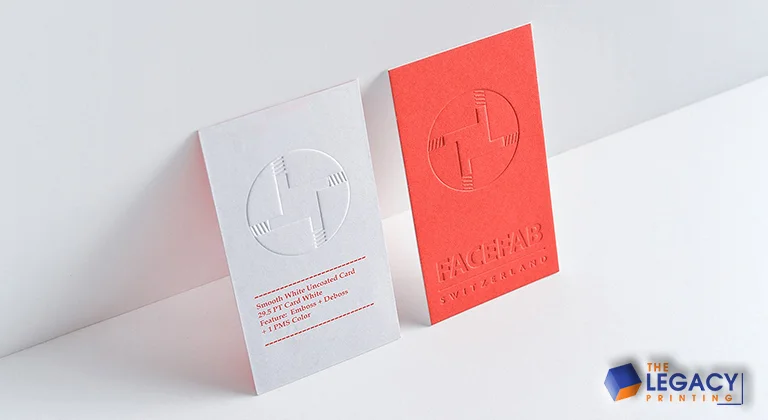Embossed vs. Debossed Printing on the product or its packaging matters for businesses as they can make their items look tempting and captivate the attention and interest of potential buyers. Credibility matters a lot in retail businesses as the market is huge. There’s extensive competition, with multiple brands in one category vying for the top slot and making their items worth buying.
Getting the product and instilling unique features in it is not enough. We are part of the era where consumers rush to the stores to buy the commodity that fulfills their needs and looks enticing in its presentation. How tempting an item is has a direct role in persuading potential customers and positively altering their mindset toward the brand.
Custom printing is important as every brand wants to improve its worth and make the product appear more valuable to the end user. It enables them to get the design, text, label, or image imprinted on the product encasing that reflects the brand identity. If the printing on an item is attractive from the user’s perspective, it facilitates the buying process.
People who run retail businesses are familiar with embossing and debossing. These extremely useful printing techniques revamp the product display and make it worth looking for the human eye. In both methods, specially designed metal plates are used to carve the design. The great thing about their usage is that there are no restrictions, and you can ask the printing enterprise to engrave the design of your choice on paper, garments, cards, or anything else.
What Is The Difference Between Embossed And Debossed
Both embossing and debossing create an exquisite printing effect that leaves a long-lasting impression when a user sees the product first. They feel great when you touch a fashion item or a business card with your hand. The raised effect through embossing adds more elegance and the depressing effect is caused when we apply the metal plates of the desired shape to the product creating a depressed image effect. The list of emboss vs. deboss features is large, and the retailers weigh the pros and cons before applying.
Businesses have different needs, and it’s impossible to conclude which is better. Depending on the final product look, you can choose either option to make the commodity’s look stand out. The embossed vs. debossed meaning is different, giving a contrasting look after the printing process.
What is Embossing
Embossing is pressing or sculpting a design onto a material such as cardboard, leather, or fabric to give it a raised, nearly three-dimensional appearance. You can do it on a large scale where the industries use highly specialized equipment.
In this printing method, the printing experts take the help of a die to lift pictures from the paper or card stock of the product or the packaging box. Doing so generates a 3D look that draws attention to the spot you want your target audience to focus on. The embossed section magnifies the look and makes the specific area more prominent.
A Brief History of Embossing
Embossing started way back in the 15th century. It was first utilized to manufacture high-end stationery using hot stamping plates. Embossing services became more inexpensive and available by the nineteenth century. Coins were usually made using embossing processes.
The embossing possibilities have only grown as time has passed; they are now utilized on papers and stationery. Today, there are various ways to generate the embossed appearance on paper, each with its benefits and drawbacks.
Types Of Embossed Printing
There are multiple techniques of embossing, and some of the most notable ones are mentioned below:
Blind Emboss
Instead of using ink, this technique entails carving the pattern directly into the material. Blind embossing is commonly seen on t-shirts, hoodies, and outerwear. It creates a cleaner effect on the garments and gives them a neat and subtle look.
Single-Level Emboss
Single-level embossing is the appropriate solution if you’re running low on budget and looking for a cost-effective solution. This is the most basic embossing, in which the design is raised and applied to the commodity.
Multi-Level Emboss
This multi-level embossing offers a more detailed view of the design and gives it a special look. It also creates a unique texture in the background. Under this technique, the raised effect is applied on different levels.
Registered Emboss
The embossed design is generated first, followed by a second design. Ink, foil stamping, punching, or embossing create the dual structure. The printed image gives a protruding look to the design and enhances the item’s worth.
Sculptured Embossing
It’s a procedure that’s done by hand. The printing experts create the design from a sketch or photograph with different depth levels to create a multi-dimensional and realistic image.
Glazing
The technique of polishing the embossing is known as glazing. On darker-colored material, glazing has been a well-renowned technique. When pressing the die, the pressure and heat are greatly enhanced. This pressure contributes to the sparkle that glazing provides. You can burn lighter-colored papers to change the color. If done right, this provides for fantastic design contrasts. The heat plays its part in altering the color and produces the glazing effect, which adds shine.
What Is Debossed Printing?
Debossing is the polar opposite of embossing. Instead of creating a raised effect, it deepens the image or logo into the print piece. As a result, we see a more engraved logo pushed into the paper.
The metal die is used for stamping on the product, and it’s applied to the specific area to produce a debossed design. The main difference is that debossing does not interfere with the opposite side of your stock. As a result, you can deal with both sides, which isn’t the case with embossing.
Like embossing, debossing begins with fabricating a die and counter-die of your desired image, logo, or design. Debossing can be done with or without ink and with or without additional printing methods like foil stamping or offset printing. Get A Quote
It is embossed vs. Debossed: Which one is perfect?
The embossing or debossing technique you choose will be determined by how you want your finished product to look and, in certain cases, the material you want to emboss or deboss. With either approach, a designer can be as inventive as they want! Impressing or depressing an image into your materials, whether simple or sophisticated, can significantly influence the end outcome. Businesses usually consider the audience’s intent and product type before choosing the embossed vs. debossed option.
The debossing adds depth to the design and dives deep to produce a sophisticated and charming final look. Instead of being prominent outside, it’s deeper, bringing more elegance and a glazing look. These designs appear more on the inside, making them more secure from harsh conditions or the fear of damage.
Uses of Embossing and Debossing
Embossing paper items such as cards, letter writing paper and envelopes, thank you notes, invitation cards, paper gift bags, greeting cards, and other types of paper or card-based stationery is very common. It takes a simple embossed design to make the product more attractive and enhance sales.
The most common embossing uses are business cards, greeting cards, book covers, and packaging. Large organizations frequently utilize embossed letterheads, cards, and office stationery to project a professional yet attractive image.
For blind people, embossing is widely utilized, with books embossed in braille. There’s also a wide usage of embossing on credit cards, debit cards, and national identity cards. Usually, the steel dies are used to emboss the figures or any text on the cards to give them a solid look and shape. In retail, embossing is used on garments to give a raised effect, beautifying the look and increasing the worth of casual and business dresses.
On the other hand, the debossing immerses the text or logo into the product design and offers more depth and vigor. The deboss can be carried out on plastic, metal, and paper. But it provides the best results on the paper because the method for pressing needs to be high quality when applied on a hard metal surface.
Brands in the allure beauty box industry use emboss and deboss finishing on the product encasing to exude a luxurious and high-end feel and captivate the attention of women audience who have a better aesthetic sense than men and are great at judging the item from its appearance. Although we have entered the digital world, musicians and song composers get their CD covers embossed or debossed to highlight their name or the album’s title.
Businesses realize they can’t downplay the importance of aesthetics and visual appeal in custom printing. Creating a positive feel for the customers is important for the brands as it directly influences the purchasing intent. Brands use both finishing options to add value to the item and give it a premium feel.

 Cosmetic Display Boxes
Cosmetic Display Boxes
 Cream Boxes
Cream Boxes
 Eye Shadow Boxes
Eye Shadow Boxes
 Eyelash Boxes
Eyelash Boxes
 Eyeliner Boxes
Eyeliner Boxes
 Foundation Boxes
Foundation Boxes
 Hiar Extension Boxes
Hiar Extension Boxes
 Lip Balm Boxes
Lip Balm Boxes
 Lip Gloss Boxes
Lip Gloss Boxes
 Lipstick Boxes
Lipstick Boxes
 Makeup Boxes
Makeup Boxes
 Mascara Boxes
Mascara Boxes
 Nail Polish Boxes
Nail Polish Boxes
 Perfume Boxes
Perfume Boxes
 Scrub Boxes
Scrub Boxes
 Serum Boxes
Serum Boxes
 Bakery Boxes
Bakery Boxes
 Cake Boxes
Cake Boxes
 Candy Boxes
Candy Boxes
 Cereal Boxes
Cereal Boxes
 Chocolate Boxes
Chocolate Boxes
 Coffee Boxes
Coffee Boxes
 Cookie Boxes
Cookie Boxes
 Cup Cake Boxes
Cup Cake Boxes
 Donut Boxes
Donut Boxes
 Macaron Boxes
Macaron Boxes
 Muffin Boxes
Muffin Boxes
 Pastry Boxes
Pastry Boxes
 Popcorn Boxes
Popcorn Boxes
 Snack Boxes
Snack Boxes
 Tea Boxes
Tea Boxes
 Truffle Boxes
Truffle Boxes
 Wine Boxes
Wine Boxes
 Bux Board Packaging
Bux Board Packaging
 Kraft Boxes
Kraft Boxes
 Mailer Boxes
Mailer Boxes
 Bath Bomb Boxes
Bath Bomb Boxes
 Candle Boxes
Candle Boxes
 Cardboard Boxes
Cardboard Boxes
 Corrugated Boxes
Corrugated Boxes
 Die-Cut Boxes
Die-Cut Boxes
 Display Boxes
Display Boxes
 Holographic Boxes
Holographic Boxes
 Medicine Boxes
Medicine Boxes
 Pillow Boxes
Pillow Boxes
 Product Packaging
Product Packaging
 Pyramid Boxes
Pyramid Boxes
 Showcase Boxes
Showcase Boxes
 Soap Boxes
Soap Boxes
 Subscription Boxes
Subscription Boxes
 Tie Boxes
Tie Boxes
 Games Boxes
Games Boxes
 Christmas Boxes
Christmas Boxes
 Favor Boxes
Favor Boxes
 Gable Boxes
Gable Boxes
 Handle Boxes
Handle Boxes
 Ornament Boxes
Ornament Boxes
 Jewellery Boxes
Jewellery Boxes
 Telescoping Rigid Boxes
Telescoping Rigid Boxes
 Textured Boxes
Textured Boxes
 Rigid Gift Boxes
Rigid Gift Boxes


